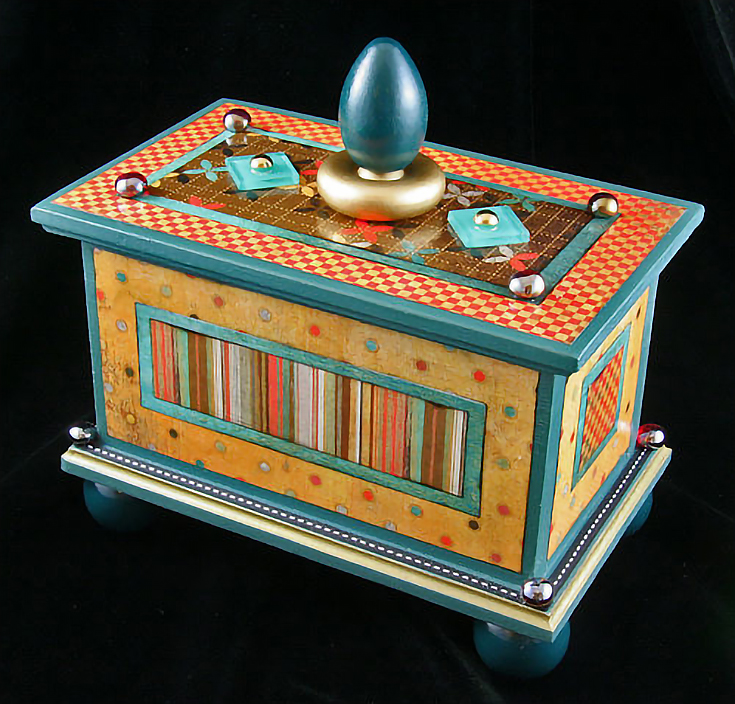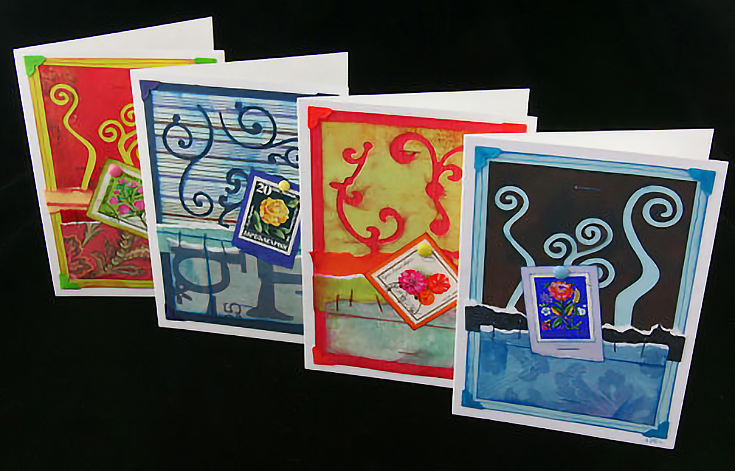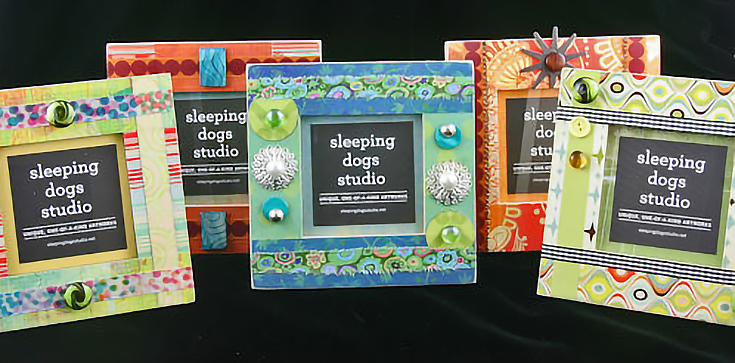 Carolyn Madvig worked in corporate America for 25 years, often feeling unfulfilled. But when her employer decided to downsize, she saw it as a sign to turn her hobby business into a full-fledged, money-making adventure—and she has never regretted it.
Carolyn Madvig worked in corporate America for 25 years, often feeling unfulfilled. But when her employer decided to downsize, she saw it as a sign to turn her hobby business into a full-fledged, money-making adventure—and she has never regretted it.
Creating art fulfills her, makes her feel alive, and relaxes her all at the same time.
Alyice: You’ve been creating handcrafted pieces of art, using various forms of paper and embellishments for over ten years. Today this medium would be known as mixed media art. Was this the name for it when you got started or did it go by another name?
Carolyn: I think if it had a name, it would have been called “Outsider Art” since mixed media was just becoming a recognized art form in the craft world.
There can still be a sense from some—although it’s improving—that mixed media and handcrafted items are not “fine art.” What I know about the hard work and amazing creativity of some of our artist friends convinces me that is not the case, however.
I almost see the growth of handmade items as a re-birth of the Arts & Crafts movement! We have had increased interest in our products—as have most of our artist friends—as the economy has suffered. It’s as if the public has decided that if they can only afford one item, they want it to be the BEST and most unique item possible.
Alyice: There’s a lot of mixed media work on the market these days, how do you differentiate yours from the rest?
Carolyn: I don’t know that we go in with the idea of making items that are specifically “different” from others. . . part of the reason may be that ALL of our designs are one-of-a-kind, even our greeting cards.
As a result, even if we use a particular piece of paper, or vintage lace, or hand-stamped images more than once, they are never in the same combination.
I think we do have a style though; people will tell me that they saw our items and that they could tell they were Sleeping Dogs Studio products. . . but it is a style that has morphed into being based upon what we like; and the type of products we like to use.
Alyice: Artists often wonder if there are any copyright infractions to worry about when using specialty papers in their art. What has been your experience in this area?
Carolyn: This is an important consideration in mixed media work. We are primarily protected by the fact that all of our items are 100% handmade and one-of-a-kind. Most stamped images, papers, etc. are made to be used in this way, and provide what they call “angel policies” that cover such usage.
In addition, we try to go above and beyond by ensuring that any vintage images we use are more than one hundred years old (typically, the copyright has expired at that point) and are purchased through reputable dealers or are from our own families.
Whenever we aren’t 100% certain that an item is “safe” to use, we ask the dealer! Better safe than sorry. . . but again, our specific usage of the items tends to avoid any problems.
Alyice: What is the most challenging part about creating mixed media art?
Carolyn: I enjoyed all of the questions posed—they were very thought-provoking, but perhaps none more so than this one!
I feel as if I’m cheating, but the honest answer is I don’t find it challenging. I find it broadens me artistically, perhaps more than any other artwork I have ever done.
Mixed media is so very “free” and open.
You want to sew on your piece? Go for it! Add silk flowers? Why not! Use an old typewriter to print the perfect finishing touch/slogan? Perfect! For that reason, I think I’d have to say that to me, mixed media is the most freeing of media I’ve worked in.
Alyice: What is your creative process like?
Carolyn: I don’t practice a technique every day, although I know many artists who have found this to be an excellent way to break through a “block.” In general, I find the best option is to just dive in! Particularly when one is feeling uninspired, just getting down to it can provide some amazing results!
I do sometimes find that one particular method works well and that is to pick an embellishment or piece of paper that I have been avoiding using a force myself to try something new with it. Typically, these exercises result in some of my favorite end products!
Alyice: As you know, art is very subjective in nature. What some people like, others do not. I’m sure you’ve received both positive and negative feedback in your career, but what I want to know is how you handle the negative criticism, especially when it hurts deep down within your soul?
Carolyn: I have what is probably a weird philosophy about this because every item we make is one-of-a-kind, I make them to please myself, and my own aesthetic.
My hope is obviously that someone else will also enjoy them, and say “That’s beautiful!” or “That makes me feel happy!” But my goal is to make whimsical, fun, heartfelt art that I love. As a result, if someone doesn’t like it, I am not crushed as some artists might be.
In addition, we make so many items and styles that often a customer who doesn’t find one item appealing will like something else. But I think it’s really when you make what you love that the “magic” happens!
Alyice: You sell your art through various specialty shops. Can you tell us how you got started?
Carolyn: It began in our hometown. Several local stores asked if they could carry our work, then, as we attended art fairs, other stores saw our products and asked if they could carry them as well. That led us to believe that perhaps if we actually marketed our products, other stores might be interested too.
Today, I have my own marketing plan for each year, as well as a sales rep that helps us find new locations for our work. The growth has been awe-inspiring and very gratifying!
Alyice: Some specialty shops require you to sign a consignment agreement (where you loan them your work and you get paid only when a piece sells). How do you feel about consignments?
Carolyn: We still have several stores with which we have a consignment arrangement. It is not unusual for us to enter a new relationship with a store on a consignment basis, and after success is proven, move to a wholesale basis instead.
Regarding contracts I would say:
– Make sure you AND the store sign one, and that it includes the answers to all questions you might have, including who will be paying for shipping, etc.
– If you have a concern, add that into the contract. (While we have had great luck with store owners, I think having an item in writing can ensure that there is no potential for misunderstanding.)
– The consignment arrangement should be 60% to the artist and 40% to the store. I’ve had some stores who prefer 50/50—but this is not the norm nationally, and because you are taking on the full risk (i.e., they are only paying you AFTER the item is sold), I think this percentage is fair.
– Any items that remains unsold after an agreed-upon period of time should be returned to you in good condition.
– A consignment arrangement also typically means that the store agrees to sell at your suggested retail price, a dollar amount which you set. While wholesale clients are purchasing your items outright, and as the “owners” of the products can determine their own price, a consignment store should definitely agree to sell at your prices. If they do not, any mark-up represents a skew to the 60/40 split.
Alyice: If an artist wanted to approach a specialty shop in hopes of becoming a wholesale client, how should he or she go about it?
Carolyn: First, I would do research—online or in person—to determine stores that you think might be a good fit for your products. Once that determination has been made, I would not simply walk into a store without an appointment and try to show your items. My experience is that store owners are VERY busy people, and may not be able to give your items or presentation the attention it deserves.
As a result, I always communicate first with them by e-mail. And perhaps I have to send them 3-4 messages before I get a response, and/or make it through their spam filters! Those that have no interest will typically respond in that regard. Others will ask to see more: a catalog, a sales sheet, a web site, etc.
We often provide samples of items to stores that are located a long distance away. . . a picture may tell 1,000 words, but in the age of Photoshop, a vendor really can’t tell exactly what your item looks like until they see it in person. If a store owner wants to see samples, it is almost guaranteed that they will decide that they want to pursue at least a small, starting order.
With these simple steps, we have been able to grow from just 9 stores at the end of 2010 to almost 70 by the end of 2011.
Alyice: You’re very good at diversifying your art income: commission pieces, online sales, retail shops, art fairs. How has diversification helped your business and what have you learned about making it all work together?
Carolyn: Part of the diversification you mention is simple paranoia, and not wanting to give up on any income stream in a bad economy! Nonetheless, if you can find time to give all of these items attention, it can really be worth your while.
For us, the two areas that have slipped are art fairs and online sales. The art fairs are expensive to attend, particularly for a product that is paper-based, and if it rains we simply cannot take the risk (even if already in town ready to set up!) of putting our items out for fear that they will all be ruined.
The online stores are simply an issue of inventory—I find it difficult to maintain the items online, do the online marketing necessary to truly succeed, etc., and still meet our outstanding retail store orders.
So after a year of doing it all, those are likely two areas we will concentrate less upon in 2012.
But we based that decision upon cold, hard facts after trying it all, sucking it up, and knowing that we were going to be over-worked in 2011. . . I would not have wanted to make that decision without the statistics to back it up.
As a result, I’d say diversify slowly and keep track of what works and what doesn’t. Then concentrate on those venues that provide the biggest return upon your investment most fully. . .
Learn more about Carolyn Madvig and her art at www.sleepingdogsstudio.net.
This post may contain affiliate links.



